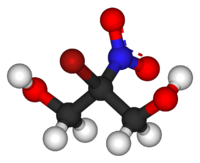2-bromo-2-nitropropane-1,3-diol
 |
|
 |
|
| Names | |
|---|---|
|
IUPAC name
2-bromo-2-nitropropane-1,3-diol
|
|
| Identifiers | |
|
3D model (JSmol)
|
|
| ChemSpider | |
| ECHA InfoCard | 100.000.131 |
| KEGG | |
| UNII | |
|
|
|
|
| Properties | |
| C3H6BrNO4 | |
| Molar mass | 199.989 g/mol |
| Appearance | white |
| Melting point | 130 °C (266 °F; 403 K) |
| Boiling point | 140 °C (284 °F; 413 K) (decomposes) |
| Pharmacology | |
| QD01AE91 (WHO) | |
|
Except where otherwise noted, data are given for materials in their standard state (at 25 °C [77 °F], 100 kPa).
|
|
|
|
|
| Infobox references | |
Bronopol (INN) is an organic compound that is used as an antimicrobial. It is a white solid although commercial samples appear yellow.
The first cited synthesis of 2-Bromo-2-nitro-1,3-propanediol is 1897 according to Molbase.
Bronopol was invented by The Boots Company PLC in the early 1960s and first applications were as a preservative for pharmaceuticals. Owing to its low mammalian toxicity (at in-use levels) and high activity against bacteria (especially the troublesome Gram-negative species), bronopol became popular as a preservative in many consumer products such as shampoos and cosmetics. It was subsequently adopted as an antimicrobial in other industrial environments such as paper mills, oil exploration and production facilities, as well as cooling water disinfection plants.
Bronopol is produced by the bromination of di(hydroxymethyl)nitromethane, which is derived from nitromethane by a nitroaldol reaction. World production increased from the tens of tonnes in the late 1970s to current estimates in excess of 5,000 tonnes. Manufacturing today is the business of low cost producers, mainly in China.
Bronopol is used in consumer products as an effective preservative agent, as well as a wide variety of industrial applications (almost any industrial water system is a potential environment for bacterial growth, leading to slime and corrosion problems - in many of these systems Bronopol can be a highly effective treatment).
The use of bronopol in personal care products (cosmetics, toiletries) has declined since the late 1980s due to the potential formation of nitrosamines. While Bronopol is not in itself a nitrosating agent, under conditions where it decomposes (alkaline solution and/or elevated temperatures) it can liberate nitrite and low levels of formaldehyde and these decomposition products can react with any contaminant secondary amines or amides in a personal care formulation to produce significant levels of nitrosamines (due to the toxicity of these substances, the term 'significant' means levels as low as 10s of parts per billion).
...
Wikipedia
